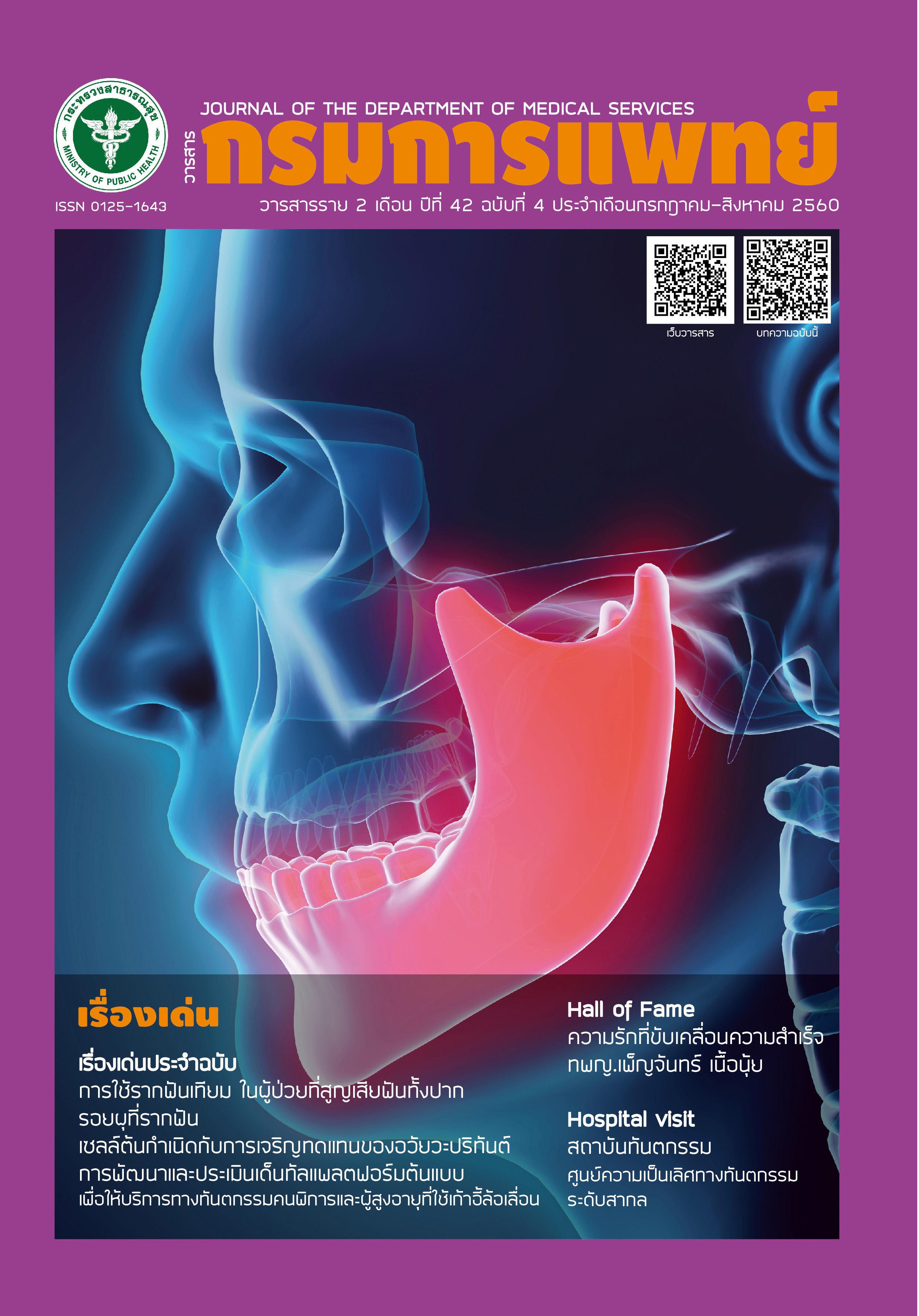Oral Health Status and Severe Caries Risk Factor in Primary Dentition among Pre-School Child in Nursery
Keywords:
Oral health status, Primary dentition, Pre-school child, Caries risk factorReferences
American Academy of Pediatric Dentistry. Policy on early childhood caries (ECC): classifications, consequences, and preventive strategies. Pediatr Dent 2015; 37:50-2.
กองทันตสาธารณสุข กรมอนามัย กระทรวงสาธารณสุข. รายงานผลการสำรวจสภาวะสุขภาพช่องปากระดับประเทศ ครั้งที่ 7 พ.ศ.2555-2556 ประเทศไทย. กรุงเทพมหานคร: โรงพิมพ์สานักกิจการองค์การทหารผ่านศึก; 2556: 123-4.
สิทธิชัย ขุนทองแก้ว.วิทยาการโรคฟันผุ.พิมพ์ครั้งที่ 2. กรุงเทพฯ: กรุ๊ปเพลส; 2552.
จันทนา อึ้งชูศักดิ์, ปิยะดา ประเสริฐสม. โรคฟันผุในฟันน้ำนม.วิทยาสารทันตสาธารณสุขฉบับพิเศษ 2549; 11:1-2
ประไพ ชุณหคล้าย, ธีมาภรณ์ ณ สงขลา. สภาวะทันตสุขภาพของเด็กโรคหัวใจพิการแต่กำเนิด.วารสารกรมการแพทย์ 2548; 30: 571-9.
Ripa LW. Nursing caries: a comprehensive review. Pediatr Dent1988; 10:268-82.
จิตตพร นิพนธ์กิจ .ปัจจัยที่มีอิทธิพลต่อการเกิดโรคฟันผุในเด็กอายุ 1-3 ปี ของจังหวัดเชียงราย ปี 2549.วิทยาสารทันตสาธารณสุข2550;12: 17-29.
มาลี วันทนาศิริ. การประเมินผลการปรับพฤติกรรมบริโภคที่มีผลต่อโรคฟันผุของเด็กเล็ก ในศูนย์พัฒนาเด็กเล็กตำบลลำไทร อำเภอลำลูกกา จังหวัดปทุมธานี.วิทยาสารทันตสาธารณสุข 2551;13: 7-19.
Milnes AR. Description and epidermiology of nursing caries. J public Health Dent 1996; 56:38-50.
จีรศักดิ์ ทิพย์สุนทรชัย.การศึกษาเปรียบเทียบอัตราการเกิดโรคฟันผุเด็กที่เข้าร่วมโครงการและไม่เข้าร่วมโครงการแม่ลูกฟันดี 102ปีสมเด็จย่า จังหวัดบุรีรัมย์ วิทยาสารทันตสาธารณสุข 2551; 13:16-24.
Hallett K, O’Rourke P. Dental caries experience of preschool children from the North Brisbane region. Aust Dent J 2002; 47:331-8.
Reisine ST. Psoter W. Socioeconomic status and selected behavioral determinants as risk factors for dental caries. J Dent Educ 2001; 65:1009-16.
WHO. Oral health surveys: basic methods, 4th ed. Geneva; 1997.
สุมนฑรา วิทยวานิชย์. การดูแลสุขภาพช่องปากเด็กของผู้เลี้ยงดูเด็กกับสภาวะฟันน้านมผุของเด็กวัย 3 ปีในคลินิกเด็กดี โรงพยาบาลองครักษ์ จังหวัดนครนายก. วิทยานิพนธ์สาธารณสุขศาสตรมหาบัณฑิต:คณะสาธารณสุขศาสตร์ มหาวิทยาลัยมหิดล;2555.
Attavanich P, Punya-Ngarm Y, Punya-Ngarm R. The relation of socio-economic factors and health behaviors of the parents to caries status of a group of 3-year-old children in Bangkok. CU Dent J 2008; 31: 261-72.
Milnes AR. Description and epidemiology of nursing caries. J Public Health Dent 1996; 56:38-50.
สมนึก ชาญด้วยกิจ, สุณี วงศ์คงคาเทพ, ขนิษฐ์ รัตนรังสิมา, อังศนา ฤทธิ์อยู่. ปัจจัยที่มีอิทธิพลต่อการเกิดฟันผุของเด็กไทยอายุ6-30เดือน.วารสารทันตกรรม2547; 54:123-36.
Marinho VC, Higgins JP, Logan S, Sheiham A. Fluoride vanishes for preventing dental caries in children and adolescents. Cochrane Database of Syst Rev 2013;7: CD002279.
Ismail Al. Prevention of early childhood caries. Community Dent Oral Epidemiol 1998; 26:49-61.
Verrip GH, Kalsbeek H, Eijkman MAJ. Ethnicity and maternal education as risk indicators for dental caries, and the role of dental behavior. Community Dent Oral Epidemiol 1993; 21:209-14.
Grindefjord M, Dahllof G, Nilsson B, Modeer T. Stepwise prediction of dental caries in children up to 3.5 year of age. Caries Research 1996; 30:256-66.
Hallett KB, O’Rourket PK. Dental caries experience of preschool children from the North Brisbane region.Aust Dent J 2002; 47:331-8.
Chan SC, Tsai JS, King NM. Feeding and oral hygiene habits of preschool children in Hong Kong and their caregivers' dental knowledge and attitude. Int J Paediatr Dent 2002;12:322-31.
Tinanoff N, Kanellis MJ, Vargas CM. Current understanding of the epidemiology, mechanism, and prevention of dental caries in preschool children. Pediatr Dent 2002; 24 :543-51.
Bo-Hyoung J, Deuk-Sand M, Hyock-Soo M, Se-Hyun H, Horowitz AM. Early Childhood Caries: prevalence and risk factors in Seoul, Korea. J Public Health Dent 2003; 63 : 183-8.
Al-Hosani E, Rugg-Gunn A. Combination of low parental educational attainment and high parental income related to high caries experience in pre-school children in Abu Dhabi. Community Dent Oral Epidemiol 1998; 26:31-6.
อุษา ยิ้มสุวรรณ. การสำรวจเทคนิคการเลิกใช้ขวดนมของเด็กอายุ1.5ปี-3.5ปีที่มารับบริการที่สถาบันสุขภาพเด็กแห่งชาติมหาราชินี(โครงการนาร่อง). วิทยานิพนธ์หลักสูตรเพื่อวุฒิบัตรสาขากุมารเวชศาสตร์: สถาบันสุขภาพเด็กแห่งชาติมหาราชินี; 2552.
Rajab LD, Petersen PE, Bakaeen G, Hamdan MA. Oral health behavior of schoolchildren and parents in Jordan. Int J Paediatr Dent 2002; 12:168-76
Mohebbi SZ, Virtanen JI, Vahid-Golpayegani M, Vehkalahti MM. Feeding habits as determinants of early childhood caries in a population where prolonged breastfeeding is the norm. Community Dent Oral Epidemiol 2008; 36: 363-9.
Thitasomakul S, Piwat S, Thearmontree A, Chankanka O, Pithpornchaiyakul W, Madyusoh S. Risks for early childhood caries analyzed by negative binomial models. J Dent Res 2009; 88: 137-41.
สุธา เจียรมณีโชติชัย, สุปราณี ดาโลดม, นนทลี วีรชัย, สุณี วงศ์คงคาเทพ, ฤดี สุรารักษ์.ระดับความเสี่ยงการเกิดโรคฟันผุของอาหารประเภทอาหารว่างของไทย. วารสารการส่งเสริมสุขภาพ 2547; 27:44-50.
Holbrook WP. Dental caries and cariogenic factor in pre-school urban Icelandic children. Caries Res 1993; 27:431-7.
พนิดา เดชสมบูรณ์รัตน์, ผกาภรณ์ พันธุวดี พิศาลธุรกิจ. การประเมินความเสี่ยงต่อการเกิดโรคฟันผุในเด็ก. วารสารทันต จุฬา 2557; 37: 97-112.
Finlayson TL, Siefert K, Ismail AI, Sohn W. Maternal self-efficacy and 1-5 year-old children’s brushing habits. Community Dent Oral Epidemrol. 2007; 35:272-81.
Gussy MG, Waters EB, Riggs EM, Lo SK, Kilpatrickk NM, Parental Knowledge, beliefs and behaviours for oral health of toddlers residing in rural Victoria. Aust Dent J 2008; 53:52-60.
Downloads
Published
How to Cite
Issue
Section
License
บทความที่ได้รับการตีพิมพ์เป็นลิขสิทธิ์ของกรมการแพทย์ กระทรวงสาธารณสุข
ข้อความและข้อคิดเห็นต่างๆ เป็นของผู้เขียนบทความ ไม่ใช่ความเห็นของกองบรรณาธิการหรือของวารสารกรมการแพทย์



